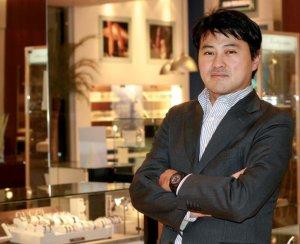The Watchman -- Executive Interview: Noritaka Ishida
Noritaka Ishida, sole proprietor of watch dealer Ishida, teaches us how to keep time on our side.
 A.Lange & Söhne platinum watch, costing 17,577,000 yen—one of their most expensive watches
A.Lange & Söhne platinum watch, costing 17,577,000 yen—one of their most expensive watches
J@pan Inc: With the economic downturn, how is the watch market surviving?
Has there been a dip in sales over the past year? If so, how do you combat this?
Noritaka Ishida: Well, it’s always been hard to sell watches as the customer base changes every year. For example, the choi waru oyaji (middle-aged bad boy) trend that was popular last year has gotten old, proving that you have to go with the trends. Also, people who made a killing in stocks last year might not be able to splurge so much this year. The last three years prior to this economic slump were pretty good, with lots of IT companies booming. Watch sales went up and we saw a bubble.
So yes, this year has been a struggle. But the level of sales is the same as before our bubble, which only lasted for a very short while.
This is in contrast to brands, where designer names are like religion. Designers tailor products to suit their brand image, and consumers traditionally subscribe to the “beliefs” of those brands, regardless of the trends. But designers aren’t managing to keep consumers like this anymore, at least not like before. The luxury market is shrinking and watches tend to be the last thing that people buy when purchasing luxury goods. It usually takes months for a customer to decide whether to buy an expensive watch.
Prices of watches are now also double what they were 10 years ago. In those days, spending 300,000 yen on a watch was seen as luxury—now, you can’t find anything in that price range and 700,000 yen is seen as normal. The problem is, the current economy is putting people in a situation where they can’t spend that much anymore. Those within the affluent market, who used to spend great amounts on luxury anyway, haven’t noticed the price increases, but the middle market, people who had to stretch to buy luxury, really feel the price increase. We began to offer payment methods where they could pay in installments, but even this has gotten hard for them. So, instead of expanding our stocks with different brands, we are concentrating on specific brands instead— ones that really fit the market.
JI: Can you tell us about the latest watch technologies? What are the most advanced watches in the world?
NI: For men, I think watches aren’t about advanced technology; they’re more like something to look at and admire. Although people like to have the technology, they’ll probably never use those features.
On the other hand, women tend to have watches for fashion reasons. For instance, a woman may buy a watch because it’s decorated with expensive diamonds. For men, it’s more of a status thing that they like to show off—like a car.
However, when you talk about advanced technology, Casio and Seiko are the best. You can throw them around and they won’t break—although that means they are more like equipment rather than ‘watches.’
JI: What watch would you advise business people to wear?
NI: Well in Japanese society, bankers for instance, should never wear fancy watches— unless they’re a high-rolling investment banker at Goldman Sachs or something and their customers are loaded too. If you are a mid-level banker, wearing a flashy Rolex will probably annoy your mid-level customers.
 Noritaka Ishida, owner of watch dealer ‘Ishida.’
Noritaka Ishida, owner of watch dealer ‘Ishida.’
A watch is like clothes—it has to fit the job that you do. This is easier for our foreign customers, who have a clearly defined line between ‘on work’ and ‘off work’ time. Japanese customers tend to want a watch that can be used for both. I choose watches based on what sort of meeting I’m going to; just like I wouldn’t roll up in a Bentley for certain meetings, I choose watches depending on who I’m meeting.
In terms of what kind of watch is the most fashionable, leather straps are the best. You have to really care for them, change the bands every so often and buy a selection of straps, which can be quite expensive. Japanese people tend to be fussy with leather— while foreign people tend not to mind so much, Japanese people wouldn’t want to buy leather that smells strongly, for example.
In terms of staple watches, I have a motto: It’s called 3+1. A black watch, silver/ white watch and an unusually shaped watch is a must. Black especially is a necessity, as is a basic round one—although a square one matches better with suits. Then, the +1 watch: this should be a hardcore watch—one that’s closer to “equipment” and you can just be rough with it for activities like rock climbing and so on.
JI: How did you come into the company?
NI: Well I started off working at Disney and then at McDonalds. It was during the bubble era in the 1980s, when US businesses used to be the most attractive for Japanese people. Both those places are top-class places—not high class—but top, or perfect, in what they do. These companies have tons of manuals, and I really wanted to take the best bits from these and learn from them. And I did. I learned that although you can have reams of manuals, a good manager knows how to adapt these to their employees and how to draw out the best parts of employees.
So after McDonalds, I started working here. It was my parents’ company and we used to sell everything, from bicycles to video players—it was more like a second-hand shop, really. It was obviously better to shrink down and concentrate on something specific, and when I started getting rid of non-profitable items I was left with just watches. This was about 15 years ago, when the bubble was bursting, but watches had this strong effect—I knew then that watches could ride through this and last.
Also, I’ve always loved watches and cars—they almost go hand-in-hand for a man. But it’s easy for men to get quickly bored as well. For instance, I’m already bored of my iPhone. So good service is helping a customer choose something that they don’t get bored of. One way of doing this is to have varying services for different clientele. We want to lift each customer up to the new level—from being mid-level, they can strive to become part of the affluent level. Some people say that this is discrimination, but I think this is real “service.” Giving discounts etc. isn’t really service (in the Japanese sense). Like the tipping culture you get abroad, good service should be paid for. JI





